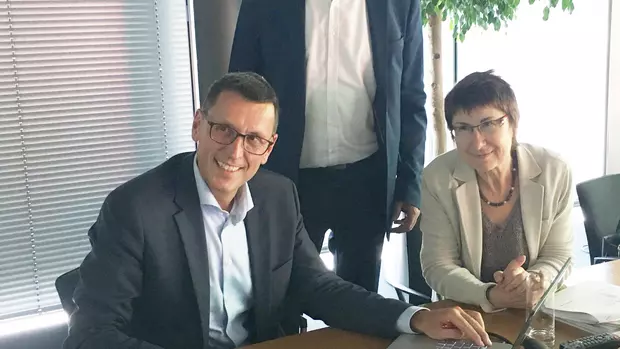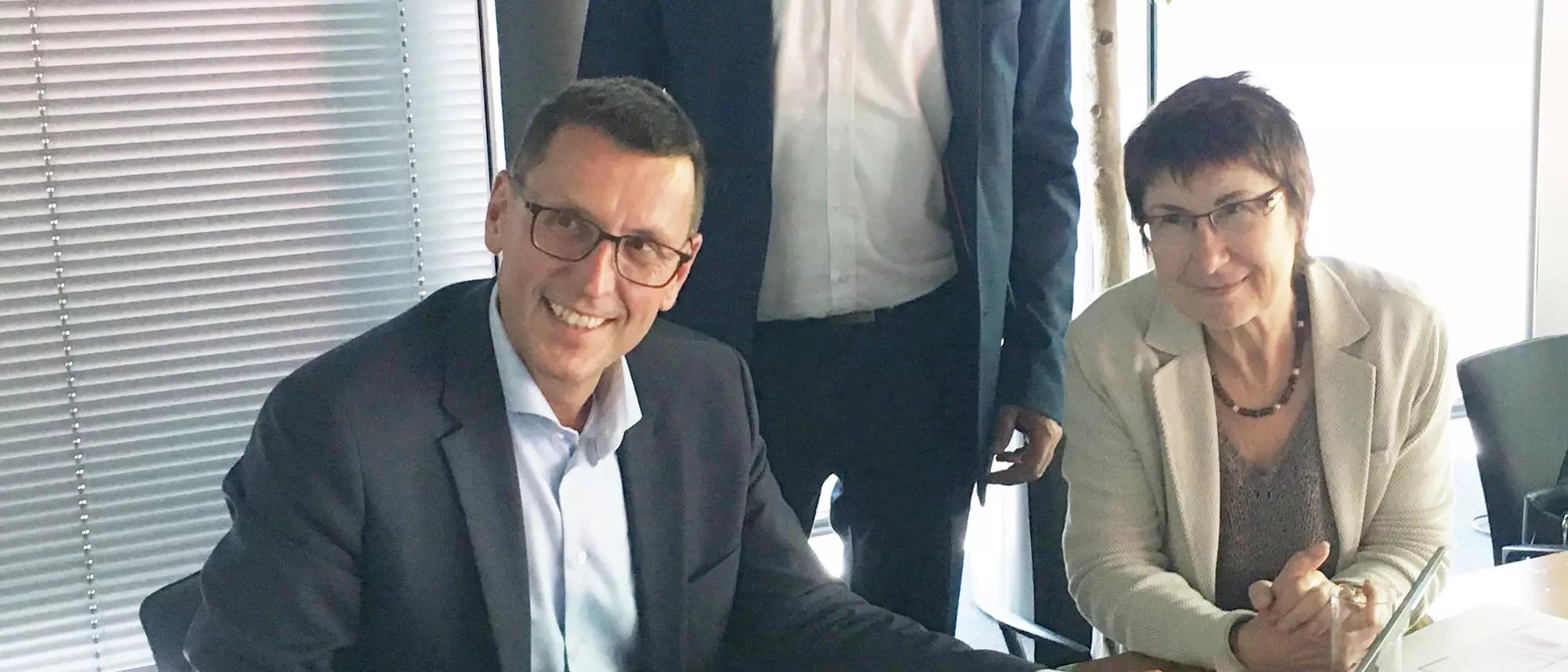
Energy transition and digitalisation - these two major topics were once again at the top of Stadtwerke Gießen's agenda in 2018. At the annual press conference on 19 June, those responsible took a look at the past twelve months. They also outlined how the transformation from a pure energy supplier to a service provider for energy and quality of life will continue in the coming year.
The energy sector is undergoing radical change. Numerous challenges - such as the advancing energy transition, increasing digitalisation and a legal framework that is not always entirely clear - require innovative and flexible solutions that go beyond the mainstream. Stadtwerke Gießen (SWG) once again demonstrated its willingness to break new ground in the past financial year. Consequently, Chairwoman of the Supervisory Board Astrid Eibelshäuser, Technical Director Matthias Funk and Commercial Director Jens Schmidt were able to present a pleasing result and positive figures for 2018 at the annual press conference on 19 June: Despite the ongoing difficult situation on the energy market, SWG generated a company result with a profit of around 2.9 million euros, which is almost constant compared to the previous year. As in previous years, Stadtwerke Gießen is distributing 2.5 million euros to its owner, the city of Gießen. Another figure underlines SWG's success: "29 cents of every euro earned remains in the region," says Astrid Eibelshäuser happily.
Electricity sales up - gas down slightly
Electricity sales climbed from 1,451 (2017) to 1,597 gigawatt hours (GWh), while gross sales revenue in this segment rose by 7 per cent from 233 to 251 million euros. In the natural gas sector, however, there was another slight decline in 2018. Sales fell from 1,233 GWh to 1,186 GWh. This is reflected in a slightly lower turnover of 48 million euros - 4 per cent or 2 million euros less than in 2017. The main influencing factor here was the high temperatures in 2018.
Sales in the heating business area also declined slightly. At 447 GWh, it fell by around 1 per cent compared to 2017, while turnover in this division fell by around 1 million euros from 37 to 36 million euros.
SWG was able to sell significantly more water than in the previous year due to the summer of the century. Sales rose from 3.8 million cubic metres to 4.16 million cubic metres. Investments fell slightly in 2018 due to the completion of TREA 2. They remained at a high level of around 18.8 million euros.
Safety and growth
Utility companies like SWG usually calculate investments in decades. That's why major innovations are always on the agenda. In 2018, for example, SWG officially put its new integrated grid control centre into operation. A huge plus for the already high level of supply security. Since the end of 2018, all grids - i.e. electricity, natural gas, heating and water grids - can be monitored and controlled from a central control centre. This offers several advantages, especially in terms of personnel planning. In addition, SWG is preparing for the expected additional workload with the new control centre and the associated new organisation. "More and more volatile electricity from wind and sun with increasing weather extremes at the same time means significantly more corrective interventions in a grid control centre," Matthias Funk sums up. "We are now also optimally positioned for this." However, the establishment of the central grid control centre not only increases security of supply. "It also enables us to offer grid monitoring and control as a service in future," explains Jens Schmidt. And because small municipal utilities in particular cannot afford the financial outlay for such a complex control system, the signs are pointing to growth.
Natural gas for the coming decades
Another major project from 2018 extends into the current year: the switch from L-gas to H-gas. The reason for this is the Netherlands' announcement that it will no longer export natural gas from 2032. L-gas - L stands for low calorific value - is still being supplied from this region to millions of customers in western Germany. Including those who live in the network area of SWG's network subsidiary Mittelhessen Netz (MIT.N). Before all these appliances can process the H-gas (H stands for high calorific) that will then be exclusively available, each individual system will need to be tested and, if necessary, adapted. "We have decided to take a different approach to our competitors," explains Matthias Funk. In fact, MIT.N, which is responsible for the mammoth project, is working with regional partner companies. From the point of view of those responsible, this offers several advantages: "Because MIT.N is responsible for project management in this constellation, the employees involved find out very quickly if there is a problem at one point or another and can react immediately," continues Matthias Funk. And his colleague Jens Schmidt adds: "Thanks to this very well-functioning cooperation, we also keep the added value in the region. That was an important concern for us and therefore a key argument for our decision."
In fact, the recording of well over 30,000 gas appliances has been completed. The teams are currently working on making the systems fit for the new gas quality. The technicians have already been able to make the first adjustments. But the majority of the conversions, which involve replacing nozzles or control boards, for example, can only take place shortly before the actual switchover date. "The switchover in Staufenberg is scheduled for September. I assume that everything will run smoothly here," explains Matthias Funk.
Even more environmentally friendly energy
SWG was able to complete another project initiated three years ago in 2019: TREA 2, a combined heat and power plant that is probably unique in the world, went into operation. At least partially. "We are still struggling with minor technical problems. But I assume that we will have solved them by the start of the heating season," explains Matthias Funk.
The special feature of the pioneering plant is the clever combination of different, already established technologies. "We have improved the proven waste incineration system from TREA 1 in detail and added two natural gas-fuelled combined heat and power plants," explains Matthias Funk. This technical trick offers two important advantages: Firstly, the hot exhaust gas from the CHP units enables the high vapour temperatures required to generate electricity. Secondly, the combination of three separate heat generators makes the system highly flexible. "We can operate the TREA 2 in the range of 1.3 to 5.6 megawatts of electrical power. This enables us to react to the current electricity demand or the current market situation," Matthias Funk is pleased to say.
If the new thermal residue treatment and energy utilisation plant runs as planned, the SWG engineers assume an annual operating performance of 7,400 hours. "This means that TREA 2 will cover the heating requirements of up to 3,300 single-family homes and the electricity needs of around 10,000 average households," adds Jens Schmidt.
Learning with Fabius
Since the end of 2018, SWG has been offering primary schools in Giessen and the region a very special programme: Fabius the dragon comes to visit with Ichmael the clown. But not just to have fun, but to teach important content. "As a first step, we developed a programme on the topic of drinking water," explains Ina Weller, company spokesperson for SWG. The programme has been very well received - both by the children and the teachers. All dates until the end of 2019 are already fully booked. SWG is planning further programmes on the topics of electricity and heat for the coming years.
Giessen in your pocket
As a company with its roots here, SWG has a particular interest in ensuring that the region prospers. That's why the local energy supplier is committed to the Giessen app. The practical tool for smartphones provides several useful services for its users - such as event dates, service offers, leisure tips, contact details of contact persons in public offices and also lots of discounts. SWG has its own section in the Giessen app. Here it is possible to enter meter readings or view contracts. "The SWG bonus world is well received," says Jens Schmidt. This is hardly surprising, as SWG's bonus world offers its customers changing, exclusive added-value offers - such as discounted offers for the pools or sauna.
Close to the customer
Keyword app. Because hardly any other app is used as often as WhatsApp, SWG has decided to use this channel to communicate with its customers. "The popular messenger service is ideal for dealing with various matters or making enquiries from the comfort of a smartphone. So it was only logical for us to offer our customers this option if they want to contact us," says Jens Schmidt, explaining the introduction.
Sending meter readings via WhatsApp has proved to be particularly popular. All you have to do is take a photo of the meter with your mobile phone and send it to SWG via WhatsApp. "It couldn't be easier," says Jens Schmidt happily. In addition, SWG also answers numerous general questions that now reach SWG via the new channel - for example about opening hours or prices.
Of course, SWG fulfils all data protection requirements with the WhatsApp service. That's why they exercise particular caution when it comes to individual information - such as questions about bills or requests to adjust the discounts. "Basically, whenever we need a customer number to be able to process the matter further, we rely on the tried and tested communication channels," summarises Jens Schmidt.
The path to the future
A strategy inventory is due at SWG at the end of 2019. This is when the managers will finalise the SWG 2025 strategy. "We have given a lot of thought to where we want to go and how we will get there," announces Jens Schmidt. And as you might expect, it will be in the direction of sustainability. SWG has already done a lot to achieve this with the introduction of the e-Revolution product world and the complete conversion of the MIT.BUS fleet to CO2-neutral bio natural gas. "But that's just the beginning," promises Matthias Funk. "As soon as we have further developed our "SWG2020" corporate strategy into the new "SWG2025" together with the strategy team and our managers, we will be happy to present and explain it."

